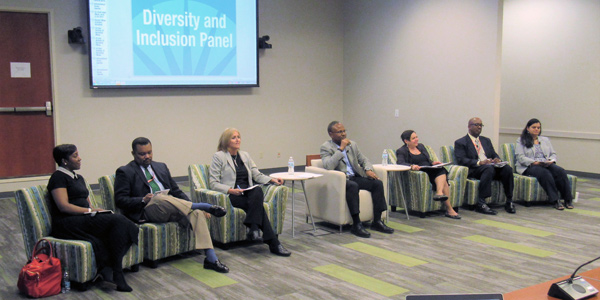By Amanda Durish Cook
CARMEL, Ind. — Six panelists shared tales of shattering the old boys’ mold and being a minority in a sea of white employees during a discussion convened by MISO last week on increasing diversity in the energy industry. The discussion was part of the RTO’s Informational Forum.

Paula Glover, CEO of the American Association of Blacks in Energy, said she has walked through workplaces where she has spotted just three African Americans among 500 employees.
“The people I engage with on a daily basis do not look like me,” Glover said, noting that while African Americans make up 12% of the workforce, their employment rate in the energy industry is 7%.
“You tell me of diversity all you want, but if I can’t pinpoint it, it’s not there,” she said. “The numbers do not pan out well for this industry.”
Counted Twice
Carolene Mays-Medley, executive director of Indiana’s White River State Park and a former Indiana Utility Regulatory commissioner and state representative, said that early in her career, she remembers being counted twice as a minority because she was both black and female.

“When I got started around 1982, it was an old boys’ club,” said Marlene Parsley, Big Rivers Electric’s director of resources and forecasting. She said starting out young and female, she learned that not “rocking the boat” earned her respect among her colleagues.
“It is important to be the person in the room sometimes, because it does give that diversity of thought,” said Korlon Kilpatrick, director of regulatory affairs for Citizens Energy Group.
MISO Executive Director of System Operations Renuka Chatterjee joined the RTO as a young engineer 17 years ago.

“To understand my personal journey, you have to understand my Ellis Island story,” said Chatterjee, who was born and raised in India and came to the U.S. in 1997. Chatterjee spoke of entering engineering school while her female cousins did not attend college. She said even while earning a doctorate in the U.S., she learned it was common to be one of a handful of female students in science and technology courses.
“I recall one interview [in India], I was viewed as not a good investment because I would get married and have babies,” she said.
Starting a Career at the Bottom
Donald Broadhurst, general manager of Midwest transmission construction and maintenance at Duke Energy, said he began his energy career as a low-level employee. “I started out at the bottom. I was a substation electrician, but I wasn’t satisfied with that,” Broadhurst said. “The most important part is you. You have to do what you want to and not let others set limits.”

Broadhurst said corporate support can improve diversity.
“It does start at the top, and you have to make sure that your organization understands that it is a priority. I think it should. It has to be weaved in the talent lifecycle from recruitment to training to succession,” he said.

Mays-Medley said she has always been frustrated when she hears a company recruiter complaining about a lack of qualified female and minority candidates. “I ask, ‘Where are you looking?’ Maybe you need to diversify your candidate pool. … You can’t say that you don’t know where to go. There are lots of places to look,” she said.
Parsley said Big Rivers will reach out to churches and community centers to cast a wider recruiting net. “A lot of times, hearing ‘not a good fit’ means, ‘They don’t think like me,’” Parsley said.
Creating Inclusion
Glover said work culture is key to creating an inclusive environment. “For companies, it is ‘Who are we?’ when people walk in the door,” she said. Glover expressed optimism for the future, saying that millennials are entering the workforce accustomed to working in diverse environments.
Broadhurst said some people think of diversity as a threat to the majority white male industry and view it as “taking someone’s seat.” He said he always viewed jobs as being earned. “When you’re an African-American leader and you bring on another African American, it’s viewed differently than if your white counterpart [hires a white employee]. But if it’s the right thing to do, you must do it. You don’t just reach back for people that look like you; you look for talent,” he said.
Glover said existing workforces feeling threatened by diversity programs is “a real thing.” She said successful diversity programs include a management discussion addressing the fear and resentment the programs may evoke.

Mays-Medley said minorities and women have to stop competing “so hard” against one another or “tearing one another down” in the workplace. “I’ve come to realize that we do it because the seats are so limited. And the vision from the top is we can only have one position. That vision from the top has to be broadened.”
MISO CEO John Bear said the RTO engages in “intentional” diversity and has a board that’s more diverse than the RTO average. MISO South Vice President Todd Hillman said the RTO is creating a diversity and inclusion resource group for its employees.
According to MISO, the RTO’s workforce is 70% male/30% female and 74% white/26% non-white. From 2013 to 2016, MISO’s new hires have been 65% male/35% female and 67% white/33% non-white. The U.S. electric power workforce as a whole is 78% male/22% female and 79% white/21% non-white, according to the RTO.



